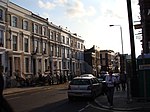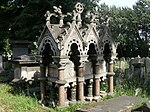Dissenters' Chapel, Kensal Green
19th-century Protestant churches19th-century churches in the United KingdomChurches completed in 1834Churches completed in 1997Churches preserved by the Historic Chapels Trust ... and 4 more
Grade II* listed churches in LondonNeoclassical architecture in LondonNeoclassical church buildings in EnglandUse British English from February 2015

Dissenters' Chapel, Kensal Green, is a working chapel with gallery attached in Kensal Green Cemetery, North Kensington, London. It is recorded in the National Heritage List for England as a designated Grade II* listed building, and is under the care of the Historic Chapels Trust.
Excerpt from the Wikipedia article Dissenters' Chapel, Kensal Green (License: CC BY-SA 3.0, Authors, Images).Dissenters' Chapel, Kensal Green
Ladbroke Grove, London Queen's Park
Geographical coordinates (GPS) Address External links Nearby Places Show on map
Geographical coordinates (GPS)
| Latitude | Longitude |
|---|---|
| N 51.5269 ° | E -0.2159 ° |
Address
Dissenters' Chapel
Ladbroke Grove 391
W10 5AB London, Queen's Park
England, United Kingdom
Open on Google Maps








